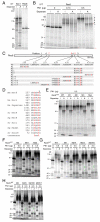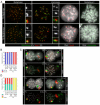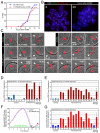Role of cleavage by separase of the Rec8 kleisin subunit of cohesin during mammalian meiosis I
- PMID: 19625504
- PMCID: PMC2909317
- DOI: 10.1242/jcs.035287
Role of cleavage by separase of the Rec8 kleisin subunit of cohesin during mammalian meiosis I
Abstract
Proteolytic activity of separase is required for chiasma resolution during meiosis I in mouse oocytes. Rec8, the meiosis-specific alpha-kleisin subunit of cohesin, is a key target of separase in yeast. Is the equivalent protein also a target in mammals? We show here that separase cleaves mouse Rec8 at three positions in vitro but only when the latter is hyper-phosphorylated. Expression of a Rec8 variant (Rec8-N) that cannot be cleaved in vitro at these sites causes sterility in male mice. Their seminiferous tubules lack a normal complement of 2 C secondary spermatocytes and 1 C spermatids and contain instead a high proportion of cells with enlarged nuclei. Chromosome spreads reveal that Rec8-N expression has no effect in primary spermatocytes but produces secondary spermatocytes and spermatids with a 4 C DNA content, suggesting that the first and possibly also the second meiotic division is abolished. Expression of Rec8-N in oocytes causes chromosome segregation to be asynchronous and delays its completion by 2-3 hours during anaphase I, probably due to inefficient proteolysis of Rec8-N by separase. Despite this effect, chromosome segregation must be quite accurate as Rec8-N does not greatly reduce female fertility. Our data is consistent with the notion that Rec8 cleavage is important and probably crucial for the resolution of chiasmata in males and females.
Figures









Similar articles
-
Rec8 phosphorylation by casein kinase 1 and Cdc7-Dbf4 kinase regulates cohesin cleavage by separase during meiosis.Dev Cell. 2010 Mar 16;18(3):397-409. doi: 10.1016/j.devcel.2010.01.014. Dev Cell. 2010. PMID: 20230747 Free PMC article.
-
Resolution of chiasmata in oocytes requires separase-mediated proteolysis.Cell. 2006 Jul 14;126(1):135-46. doi: 10.1016/j.cell.2006.05.033. Cell. 2006. PMID: 16839882
-
Aurora B/C-dependent phosphorylation promotes Rec8 cleavage in mammalian oocytes.Curr Biol. 2022 May 23;32(10):2281-2290.e4. doi: 10.1016/j.cub.2022.03.041. Epub 2022 Apr 5. Curr Biol. 2022. PMID: 35385691
-
Separase Control and Cohesin Cleavage in Oocytes: Should I Stay or Should I Go?Cells. 2022 Oct 27;11(21):3399. doi: 10.3390/cells11213399. Cells. 2022. PMID: 36359795 Free PMC article. Review.
-
Meiotic prophase-like pathway for cleavage-independent removal of cohesin for chromosome morphogenesis.Curr Genet. 2019 Aug;65(4):817-827. doi: 10.1007/s00294-019-00959-x. Epub 2019 Mar 28. Curr Genet. 2019. PMID: 30923890 Review.
Cited by
-
WAPL orchestrates porcine oocyte meiotic progression via control of spindle assembly checkpoint activity.Reprod Biol Endocrinol. 2021 Apr 19;19(1):57. doi: 10.1186/s12958-021-00740-1. Reprod Biol Endocrinol. 2021. PMID: 33874950 Free PMC article.
-
Separase-triggered apoptosis enforces minimal length of mitosis.Nature. 2020 Apr;580(7804):542-547. doi: 10.1038/s41586-020-2187-y. Epub 2020 Apr 8. Nature. 2020. PMID: 32322059
-
Is age-related increase of chromosome segregation errors in mammalian oocytes caused by cohesin deterioration?Reprod Med Biol. 2019 Sep 12;19(1):32-41. doi: 10.1002/rmb2.12299. eCollection 2020 Jan. Reprod Med Biol. 2019. PMID: 31956283 Free PMC article. Review.
-
Unique adaptations in neonatal hepatic transcriptome, nutrient signaling, and one-carbon metabolism in response to feeding ethyl cellulose rumen-protected methionine during late-gestation in Holstein cows.BMC Genomics. 2021 Apr 17;22(1):280. doi: 10.1186/s12864-021-07538-w. BMC Genomics. 2021. PMID: 33865335 Free PMC article.
-
A PP2A-B56-Centered View on Metaphase-to-Anaphase Transition in Mouse Oocyte Meiosis I.Cells. 2020 Feb 7;9(2):390. doi: 10.3390/cells9020390. Cells. 2020. PMID: 32046180 Free PMC article. Review.
References
-
- Alexandru, G., Uhlmann, F., Mechtler, K., Poupart, M. A. and Nasmyth, K. (2001). Phosphorylation of the cohesin subunit Scc1 by Polo/Cdc5 kinase regulates sister chromatid separation in yeast. Cell 105, 459-472. - PubMed
-
- Bannister, L. A., Reinholdt, L. G., Munroe, R. J. and Schimenti, J. C. (2004). Positional cloning and characterization of mouse mei8, a disrupted allelle of the meiotic cohesin Rec8. Genesis 40, 184-194. - PubMed
-
- Brar, G. A., Kiburz, B. M., Zhang, Y., Kim, J. E., White, F. and Amon, A. (2006). Rec8 phosphorylation and recombination promote the step-wise loss of cohesins in meiosis. Nature 441, 532-536. - PubMed
-
- Buonomo, S. B., Clyne, R. K., Fuchs, J., Loidl, J., Uhlmann, F. and Nasmyth, K. (2000). Disjunction of homologous chromosomes in meiosis I depends on proteolytic cleavage of the meiotic cohesin Rec8 by separin. Cell 103, 387-398. - PubMed
-
- Clyne, R. K., Katis, V. L., Jessop, L., Benjamin, K. R., Herskowitz, I., Lichten, M. and Nasmyth, K. (2003). Polo-like kinase Cdc5 promotes chiasmata formation and cosegregation of sister centromeres at meiosis I. Nat. Cell Biol. 5, 480-485. - PubMed
Publication types
MeSH terms
Substances
Grants and funding
LinkOut - more resources
Full Text Sources
Other Literature Sources
Molecular Biology Databases

